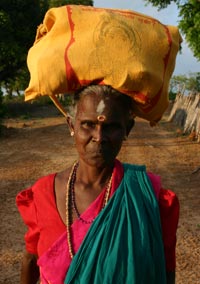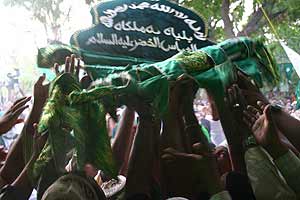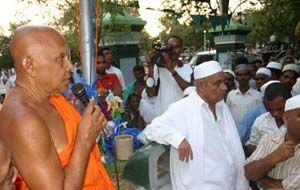
|
||||||||||||||||||||||||
|
| ||||||||||||||||||||||||

Pada Yatra 2007: With a Brave Heart and Bhakti They Walk On
Ardent devotees by the hundreds have been arriving by foot from villages on the east coast, crossing Yala National Park to attend the Kataragama festival. Pilgrims must cross nearly 100 km of jungle to reach Kataragama for the Esala season festivities. With the Okanda Malai Murugan Devale and Kataragama Maha Devale festivals occurring simultaneously, several thousands of foot pilgrims are now streaming towards Okanda, most of whom continue through to Kataragama. Some villages, like Mamangam near Batticaloa, have recently formed their own Pada Yatra societies of 100 pilgrims or more, who share the experience of Pada Yatra together. Most set out from popular starting points like Pottuvil and Okanda, but others like Mamangam start walking from their home temple. In recent years, the Pada Yatra tradition has been making a comeback after facing near-extinction following the 1983 ethnic riots. With the birth of the Kataragama Devotees Trust in 1988 and subsequent efforts to revive the foot pilgrimage tradition, pilgrims began to turn out again in substantial numbers in the mid-1990's. This year, however, Wildlife Department officials expected a far smaller turnout than in past years, citing security as the principal concern. The majority of Pada Yatra pilgrims come from villages in the Eastern Province, where recent military operations have displaced whole village populations. Tightened security in such areas, together with the absence of dana, makes pada yatra very difficult indeed across broad swathes of the North and East this year. Newly instituted security directives, moreover, have made the passage through Yala National Park an even more daunting task for pilgrims, who already must brave wild animals, frequent illness, scorching sun and sudden rains while carrying all their belongings and dry rations with them. Wildlife Department officials alone are no longer solely responsible for monitoring the foot pilgrims coming through Yala National Park. That is now principally the Army's responsibility.
With security now in the hands of the military, Wildlife Dept officials are now free to focus their attention upon their immediate mandate to monitor and protect the Park from environmental damage that occurs when it is invaded by thousands of mostly inexperienced foot pilgrims. The Department this year therefore could employ its limited resources more effectively by giving its officials explicit directions. Their instructions: No vehicles whatsoever permitted into Yala East beyond Okanda, and no polythene bags whatsoever permitted within the Park. The orders were simple, enforceable, and they were enforced. The policy, however, appeared to be directed only against vehicles and litter entering Yala from the east. Once in the Park—the Strict Natural Reserve, that is—vehicles began to appear from the west carrying food, water, and baggage for those who had signed up with a large NGO that sends its hundreds of staff—especially youths—into the jungle during the Pada Yatra season—ostensibly to serve the mostly elderly Pada Yatra pilgrims—with their every need supplied by a small fleet of tractors, pickups, and water bowsers. This pilgrim spoke at length with many villagers both in Tamil and Sinhala. Their impressions of the new kind of ‘Pada Yatra' reduced to tame adventure tourism were uniformly negative. As one villager put it, "Where there is no bhakhti, how can there be Pada Yatra? A uniform or identity card does not make one a devotee. Bhakthi must come first."
Mrs. P. Sandanapillai of Kokkattichcholai, who has walked the Pada Yatra for the past ten or more consecutive years, has seen her home and all her belongings destroyed, and all her relatives scattered as refugees. She carries upon her head a bundle twice the size of others, so that she can cook and feed the other pilgrims anywhere she goes. But this year, her big bundle—aside from its weight—only made things more difficult than ever for Sandana Amma, as she is best known. "Checking! Checking!" she says emphatically when asked her impression of this year's Pada Yatra. Ordinary pilgrims this year could expect to spend six to eight hours waiting to be processed. For barefoot pilgrims, that meant being forced to walk upon scorching hot roads in midday instead of reaching the day's destination by 9 a.m. The Pada Yatra pilgrims traditionally walk from as far as Jaffna district, taking up to two months to reach Kataragama. All along the way in normal times, villagers await their chance to offer dana to the growing bands of swamis and swami ammas, who are mostly in their 50's, 60's and 70's—some even in their 90's."Next year, if peace returns, we will walk again from Jaffna," says the ever-cheerful and optimistic Sandana Amma. "With Lord Murugan's grace, there is no problem that we cannot overcome."
Courtesy: The Sunday Times of Sunday, July 22, 2007 Patrick Harrigan has been the Kataragama Devotees Trust's Pada Yatra field representative since 1988. The 2007 pada yatra was his 20th Kataragama Pada Yatra since 1972. 2007 Pada Yatra 2004 field report #1 |
|
|
| Living Heritage Trust ©2023 All Rights Reserved |
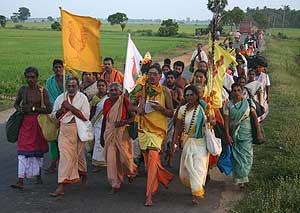
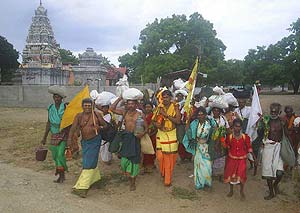
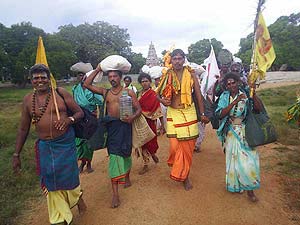
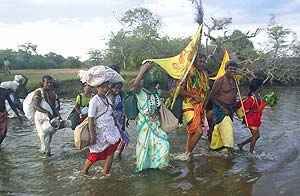
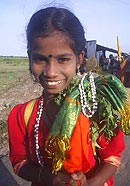 Sindhu comes from the east coastal Veddah community, who until not long ago made their livelhood by catching fish and finding wild honey in the forests. Her grandfather used to carry the Vel and lead the Veddahs from the Mutur area. He is no more, but now Sindhu is carrying a little Vel of her own.
Sindhu comes from the east coastal Veddah community, who until not long ago made their livelhood by catching fish and finding wild honey in the forests. Her grandfather used to carry the Vel and lead the Veddahs from the Mutur area. He is no more, but now Sindhu is carrying a little Vel of her own. 